Filter by
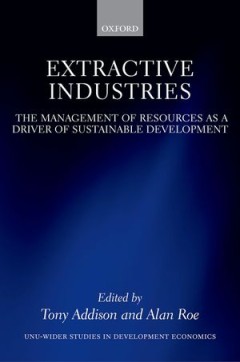
Extractive Industries
New initiatives recognize that resource wealth can provide a means, when properly used, for poorer nations to decisively break with poverty by diversifying economies and funding development spending. Extractive Industries: The Management of Resources as a Driver of Sustainable Development explores the challenges and opportunities facing developing countries in using oil, gas, and mining to achi…
- Edition
- -
- ISBN/ISSN
- 9780198817369
- Collation
- -
- Series Title
- -
- Call Number
- -
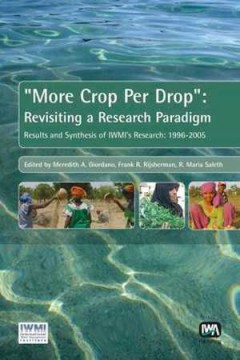
More Crop Per Drop
This volume is an analytical summary and a critical synthesis of research at the International Water Management Institute over the past decade under its evolving research paradigm known popularly as 'more crop per drop'. The research synthesized here covers the full range of issues falling in the larger canvas of water-food-health-environment interface. Besides its immediate role in sharing kno…
- Edition
- -
- ISBN/ISSN
- 9781780402284
- Collation
- -
- Series Title
- -
- Call Number
- -
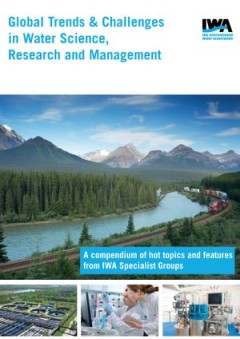
Global Trends & Challenges in Water Science, Research and Management
The global water challenge is unprecedented. Climate change, rapid urbanisation, increasing consumption and demand for food and energy, and changing land use, will leave few countries and communities unaffected. The demand for water and sanitation services is greater than it has ever been, and water has never been higher on the agenda. The Sustainable Development Goals (SDGs) not only provide a…
- Edition
- -
- ISBN/ISSN
- -
- Collation
- -
- Series Title
- -
- Call Number
- -

Deterministic Modelling of Urban Stormwater and Sewer Systems
Computer modelling of drainage systems is a discipline that has soared over the past 50 years. It is estimated that a large proportion of all cities in the world with more than 100,000 inhabitants have used computer modelling, in one way or another, for design or analysis of the performance of their drainage systems. The development and introduction of the PC in the early 1980s played a decisiv…
- Edition
- -
- ISBN/ISSN
- 9788772102696
- Collation
- -
- Series Title
- -
- Call Number
- -

Detection of Pathogens in Water Using Micro and Nano-Technology
Detection of Pathogens in Water Using Micro and Nano-Technology aims to promote the uptake of innovative micro and nano-technological approaches towards the development of an integrated, cost-effective nano-biological sensor useful for security and environmental assays. The book describes the concerted efforts of a large European research project and the achievements of additional leading r…
- Edition
- -
- ISBN/ISSN
- 9781780401089
- Collation
- -
- Series Title
- -
- Call Number
- -

Design Optimization of Wind Energy Conversion Systems with Applications
Modern and larger horizontal-axis wind turbines with power capacity reaching 15 MW and rotors of more than 235-meter diameter are under continuous development for the merit of minimizing the unit cost of energy production (total annual cost/annual energy produced). Such valuable advances in this competitive source of clean energy have made numerous research contributions in developing wind indu…
- Edition
- -
- ISBN/ISSN
- 9781789844078
- Collation
- -
- Series Title
- -
- Call Number
- -

Coastal Management in Australia
The coast is one of our most valuable assets but how is it being treated and what is being done to look after it? Coastal Management in Australia is the first book to provide a comprehensive overview of this important subject. Interesting case studies are used to illustrate human impact on coastal processes as well as demonstrating the global significance of the coast and the international impe…
- Edition
- -
- ISBN/ISSN
- 9780980723038
- Collation
- -
- Series Title
- -
- Call Number
- -
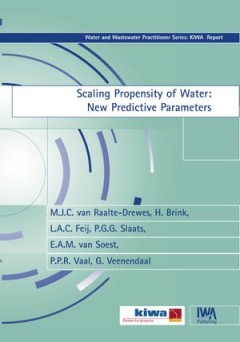
Costing Improved Water Supply Systems for Low-income Communities: A Practical…
This manual and the free downloadable costing tool is the outcome of a project identified by the Water, Sanitation and Health Programme (WSH) of the World Health Organization (WHO) faced with the challenge of costing options for improved access, both to safe drinking water and to adequate sanitation. Although limited in scope to the process of costing safe water supply technologies, a proper us…
- Edition
- -
- ISBN/ISSN
- 9781780407210
- Collation
- -
- Series Title
- -
- Call Number
- -
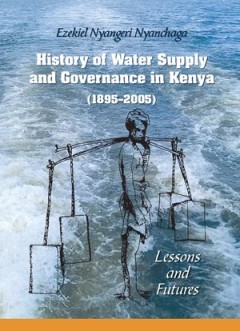
History of Water Supply and Governance in Kenya (1895-2005) Lessons and Futures
This book on the History of Water Development in Kenya transverses through a matrix of infrastructural development, administration, policy, legal and legislation framework, and evolution of various water supply technologies in an inimitably comprehensive approach. The book has carefully constructed the development over one century timeline of water supply and provided the future prediction of t…
- Edition
- -
- ISBN/ISSN
- 9789520300593
- Collation
- -
- Series Title
- -
- Call Number
- -

Constructed Wetlands for Pollution Control: Processes, Performance, Design an…
The book presents a comprehensive up-to-date survey of wetland design techniques and operational experience from treatment wetlands. This book is the first and only global synthesis of information related to constructed treatment wetlands. Types of constructed wetlands, major design parameters, role of vegetation, hydraulic patterns, loadings, treatment efficiency, construction, operation and m…
- Edition
- -
- ISBN/ISSN
- 9781900222051
- Collation
- -
- Series Title
- -
- Call Number
- -
 Computer Science, Information & General Works
Computer Science, Information & General Works  Philosophy & Psychology
Philosophy & Psychology  Religion
Religion  Social Sciences
Social Sciences  Language
Language  Pure Science
Pure Science  Applied Sciences
Applied Sciences  Art & Recreation
Art & Recreation  Literature
Literature  History & Geography
History & Geography